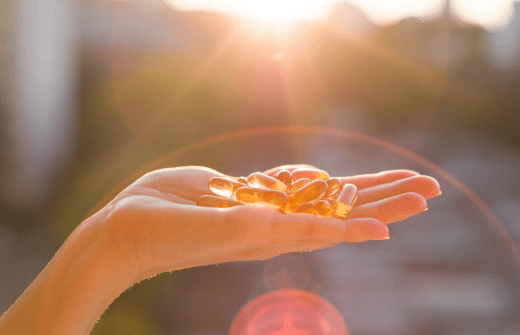Vitamin D is one of the important substances our body needs not only for healthy bones and proper functioning of the immune system. Especially during winter a lot of people suffer from vitamin D deficiency. Therefore it is good to increase its levels through dietary supplements. In today's articles, we focus on clarifying why Trime offers exclusively plant-based vitamin D and why we do not consider vitamin D from lanolin as a suitable source.
Article at a glanc:
- Plant-based versus animal-based vitamin D
- Animal origin - vitamin D from lanolin
- Technology of the production of vitamin D3 from lanolin
- Disadvantages of vitamin D made from lanolin
- Lanolin as an allergen
- Why do we prefer plant-based vitamin D?
- What are the biggest benefits of our vitamin D from algae?
- A quick reminder of important information about vitamin D
Plant-based versus animal-based vitamin D
You will find a large number of supplements on the market, which differ not only in quality, but also in the source. Majority of vitamin D3 supplements are of animal origin and producers do not always specify which form of the vitamin they use and how it was obtained. At Trime we produce supplements whose composition is as close as possible to nature and that are environmentally friendly at the same time. Therefore, plant-based vitamin D is a clear choice for us.
Animal origin - vitamin D from lanolin
A very common raw material for the production of vitamin D is lanolin, which is produced as a yellow secretion by the sebaceous glands of sheep. In principle, lanolin functions as a waterproof layer protecting sheep from bad weather (eg. in the case of cold or rain). The origin of the word lanolin comes from the Latin "lanolinum" by combining the words lana (wool) and oleum (oil). Although lanolin is classified from a chemical point of view as a wax.
Technology of the production of vitamin D3 from lanolin
The extracted wool is first washed in hot water with detergent to remove any parasites or impurities and so raw lanolin is produced. The fatty component is then separated from the non-fatty component by a process called saponification and subsequent centrifugation. Raw cholesterol is isolated using extractants and solvents. Further chemical processes lead to the creation of the final stable form of vitamin D3, that is ready for supplements production.
Disadvantages of vitamin D made from lanolin
Undesirable ingredients used in the production of vitamin D from lanolin may be pesticides or preservatives. Sheep's wool can be contaminated with pesticides, as sheep may come into contact with chemically treated plants. Also, the animals themselves and their skin are subjected to disinfectant baths against ticks and other pests. Residues of the used chemicals may then remain in their skin.
Since lanolin is of fatty nature, it can turn rancid or oxidize when exposed to the air. To extend shelf life, many producers add BHT (butyl hydroxytoluene), the most widely used synthetic antioxidant to slow the rancidity of oils and fats, to lanolin. Although BHT is considered safe in adequate amounts, trace amounts remain in human adipose tissue and there are many doubts regarding its health effects (the substance has been shown to be an animal carcinogen).
Another aspect is the ethical point of view. The wool from sheep is often obtained in a rough manner and deep cuts are then common sheep injury. Some breeders also use a drastic practice called mulesing. This involves cutting away a large amount of skin around the anus and tail to get rid of the wrinkled skin and wool that would otherwise trap feces. This "circumcision" is usually performed without anesthetics and is very painful and stressful for the sheep. The subsequent wounds can heal for a long time after the act of mulesing.
Lanolin as an allergen
The American Contact Dermatitis Society (ACDS) announces annually the Allergen of the Year. The reason is to draw attention to allergens that are common and deserve more attention because they can cause significant contact allergic reactions. Lanolin was declared as the allergen of the year 2022 by the ACDS.
Due to its softening and moisturizing properties, lanolin is used not only in cosmetics, but also in pharmaceuticals. Lanolin is considered to be a weak sensitizer and the frequency of contact allergy to lanolin is estimated to be 0.4% by the European population. However, several accompanying conditions (such as leg ulcers, perianal/genital dermatitis or atopic dermatitis) may occur. Children and the elderly are at higher risk of developing a contact allergy to lanolin.
Why do we prefer plant-based vitamin D?
At Trime, we care not only about the maximum nutritional potential of our supplements, but also about their environmental friendliness. Sustainability, ethical approach, environmental impact and respect for nature and animals are crucial to us. Therefore, products with lanolin extract are not a suitable choice for us.
Previously, plant-based vitamin D was made from mushroom extracts. But this form chemically corresponds to vitamin D2 (ergocalciferol), which is much less effective compared to vitamin D3 (cholecalciferol). Currently, the form corresponding to vitamin D2 is not considered as a sufficient source of vitamin D.
Our vegetable vitamin D3 is found in the bioavailable form of cholecalciferol and comes from a plant source of the highest quality and purity. It is obtained from non-genetically modified Algae, which is grown in strictly controlled conditions without the use of pesticides or other contaminants.
What are the biggest benefits of our vitamin D from algae?
- Clean and high quality. Algae are grown in strictly controlled conditions in a so-called closed cycle, where there is no risk of xenobiotic contamination from the surrounding environment as in the wild. No pesticides or chemical solvents are used during production. Our products do not contain synthetic preservatives.
- Sustainable and energy saving production method (the production process is not energy intensive).
- High bioavailability and the same half-life as by vitamin D3 from animal sources.
- Suitable for vegetarians and vegans
A quick reminder of important information about vitamin D
Vitamin D is a fat-soluble vitamin that has many functions in the body. It behaves more like a hormone that regulates the absorption of calcium and phosphorus, thereby contributing to maintaining healthy bones and teeth. Most cells in the body contain a receptor for this vitamin, which also points to its importance. Vitamin D is involved in proper cell division, contributes to normal muscle activity and supports the healthy function of the immune system.
The natural source of vitamin D is sunlight, which is why we increase the levels of this important vitamin by exposing our skin to the sun. Limiting factors of vitamin D synthesis have to be taken into account: for example the time of sun exposure, the wavelength of sunlight or the use of protective sun creams. For these reasons, we may not have sufficient levels of vitamin D even during the summer. The source of vitamin D during winter is represented by certain foods, such as fatty fish, which are unfortunately consumed very rarely. That is why we often suffer from a lack of vitamin D during winter and we should therefore focus on its supplementation.
You can find other articles related to vitamin D on our blog (for example Sun as a source of vitamin D or Vegan vs.non-vegan source of vitamin D).

















